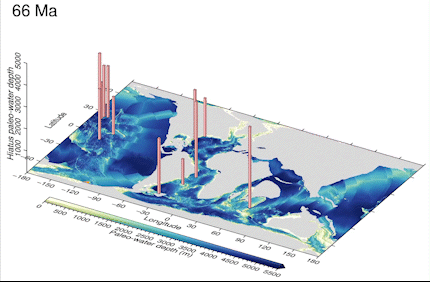Abstract: Scientific ocean drilling data collected over half a century have generated a treasure trove of data to map deep sea currents. We have compiled data from more than 200 drill sites to map the continuity of the deep sea sedimentary record and to understand how global warming– or cooling – is affecting deep ocean circulation (Geology, 2022). This is one of the missing links for predicting how future climate change may affect the oceans. Climate models have been used to argue that deep ocean circulation is slowing down, staying roughly the same, or speeding up during global warming – this inconsistency is a problem for modelling future climate trends. The observational database for deep ocean mixing used to inform ocean models only covers a few decades, leading to a poor understanding of longer-term ocean variability. This prompted us to look at the deep-sea geological record to decipher changes in the intensity of deep ocean circulation. A break in sedimentation, a hiatus, may indicate vigorous deep-sea currents, while continuous sediment accumulation indicates calmer conditions. In addition, carbonate dissolution can also create hiatuses. Combining ocean drilling legacy data with reconstructions of the width and depth of ocean basins has allowed us to track where and when hiatuses have occurred. The resulting maps reveal how the opening and closing of ocean gateways have influenced deep ocean circulation. But this project had a particularly surprising result. Over the last 13 million years, as the Earth progressively cooled and developed growing inland ice caps, hiatuses became less and less frequent, a tell-tale sign of deep-sea circulation becoming more sluggish. The period just before 13 million years ago, called the Miocene Climate Optimum, was a hothouse climate with global temperatures 3-4 °C warmer than today and sea level about 40m higher. Our results indicate that deep-ocean circulation was significantly more vigorous at that time. Satellite data suggest that large-scale ocean circulation and ocean eddies have become more intense over the last two to three decades of global warming. Our results extend these insights over much longer timescales, providing a missing observational link from the geological record to help inform future ocean models. A recent study focussed on the ocean floor around New Zealand found that the accumulation of carbonate sediment was higher during ancient periods of climate warming, despite ocean acidification during those times, implying elevated ocean productivity. Combining their results with ours leads us to conclude that warmer oceans not only have more vigorous deep circulation, but are potentially also more efficient at storing carbon – however, a more comprehensive analysis of the geological history of the ocean basins is needed to verify these ideas.
Register for the April 21-22 event at iodp.org.au on the ANZIC Forum website.
Listen to the talk on youtube.

Distribution of deep sea-hiatuses and their paleo-water depths for the Cenozoic. Height of bars indicates paleo-water depths at which hiatuses formed. Orange regions indicate contourite drifts based on estimated maximum ages of their formation from the compilation of Thran et al. (2018). Paleobathymetry of preserved seafloor reconstructed using pyBacktrack (Müller et al., 2018) while paleo-water depths of now subducted ocean floor (smooth regions) are based on Wright et al. (2020). Grey areas indicate continents and regions where paleobathymetric reconstruction was not possible.
![]()
